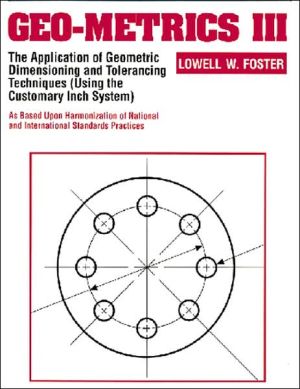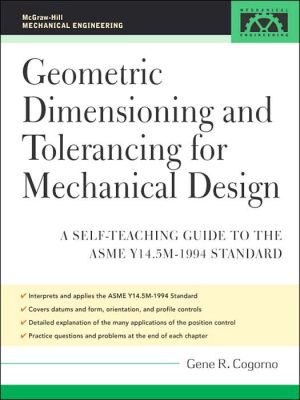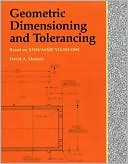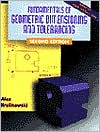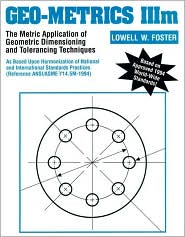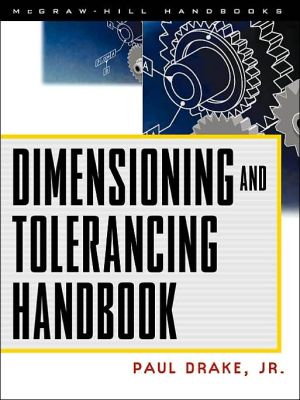Geo-Metrics III: The Application of Geometric Dimensioning and Tolerancing Techniques (Using the Customary Inch Systems)
Geo-Metrics III is an extensively revised edition of the most respected and widely-read book on geometric dimensioning and tolerancing, the technical drawing language for designing and manufacturing component parts of a mechanical product. Completely up to date, this new edition takes its reference from the content of the latest ANSI/ASME Y14.5M standard as well as harmonizing with the principles of related ISO international standards. It is also supportive of the ISO 9000 series of...
Search in google:
Geo-Metrics III is an extensively revised edition of the most respected and widely-read book on geometric dimensioning and tolerancing, the technical drawing language for designing and manufacturing component parts of a mechanical product. Completely up to date, this new edition takes its reference from the content of the latest ANSI/ASME Y14.5M standard as well as harmonizing with the principles of related ISO international standards. It is also supportive of the ISO 9000 series of international standards policies and directives.Geo-Metrics III is an indispensable guide and reference for anyone involved in engineering design, drafting, manufacturing, quality, and verification of product. In it you will find the state-of-the-art in the principles and techniques of engineering design specification, with comprehensive coverage of such topics as:Geometric characteristics and symbolsDatums and their applicationTolerances of form, orientation, profile, runout, location, and their applicationThe material condition principles MMC,LMC, and RFS, and their application...and much more.This new edition focuses on important aspects of the latest standards and the ability to represent "function and relationship" of part feature requirements which engineers have envisioned but cannot explicitly state in drawings. In addition, Geo-Metrics III emphasizes the need for recognition of the emerging international standards which are so important in present-day global communication.The author's experience and insight, evident throughout the book, will lead you to a deeper understanding of the rationale behind the standards, enabling you to apply them more effectively in your work. The principles in Geo-Metrics III, combining the latest standards and techniques of modernized engineering product specification, facilitate clear communication through the process of design, manufacturing, assembly, and verification while promoting reduced costs and higher quality.For those companies that have not yet adopted the latest ANSI standards, these reference guides are still available:Geo-Metrics II: The Application of Geometric Tolerancing Techniques (Using the Customary Inch System), Revised 1986 EditionISBN 0-201-11527-1• Paperback• 336 pages• (c)1986Geo-Metrics: The Metric Application of Geometric Tolerancing Techniques, Revised 1986 EditionISBN 0-201-11526-3• Paperback• 336 pages• (c)1986Pocket guide versions of Geo-Metrics II and Geo-Metrics III are also available. These handy guides increase the usability of this information on the manufacturing floor and serve as a quick reference to ANSI standards. These pocket guides are easy to carry and contain the crux of geometrics.A Pocket Guide to Geo-Metrics III: Dimensioning and Tolerancing (Using the Customary Inch System), 10 packISBN 0-201-63478-3• Paperback• 36 pages• (c)1995A Pocket Guide to Geo-Metrics III: Dimensioning and Tolerancing, Metric Version, 10 PackISBN 0-201-63476-7• Paperback• 36 pages• (c)1995A Pocket Guide to Geo-Metrics II: Dimensioning and Tolerancing (Using the Customary Inch System), 10 packISBN 0-201-11840-8• Paperback• 32 pages• (c)1987A Pocket Guide to Geo-Metrics II: Dimensioning and Tolerancing, Metric Version, 10 packISBN 0-201-11842-4• Paperback• 32 pages• (c)1987 Booknews A revised and expanded version of Geometrics II, this text presents the subject of dimensioning and tolerancing in order of complexity of the details, and clarifies the use of the ANSI/ASME Y14.5M standard. it also emphasizes the importance of the ongoing effort to expand the principles and to more closely incorporate international practices. For the metric version, see Geo-metrics IIIm. Annotation c. Book News, Inc., Portland, OR (booknews.com)
This text has been prepared to promote worldwide use of geometric dimensioning and tolerancing and to up-grade knowledge on the subject. Its title Geo-Metrics III attempts to represent and encourage the giant stride being taken by United States industry in its transition toward greater use of national and international standards on this subject. This text also aspires to be of value to all users worldwide as a catalyst for better understanding and to improve the state of the art. This text is a revised and expanded version of its predecessor Geo-Metrics II.\ Another major objective of this text is to promote and encourage use of the principles involved as an effective engineering, production, and quality-control language or tool which can provide economic and technical advantages.\ To further the foregoing objectives, this text is therefore presented in a format suitable for use as a teaching mechanism, both for the classroom and in-industry situations, as well as for providing a daily ready reference for engineering or production work. Geo-Metrics III is dedicated to the promoting of standardization of engineering drawing techniques in support of the American National Standard "Dimensioning and Tolerancing," ANSIASME Y14.5M-1994. This text is also dedicated to furthering worldwide efforts through the International Standards Organization (ISO) and its standards and programs (e.g., ISO/TCIO/SC5 "Geometrical Dimensioning and Tolerancing"). To this end, this text attempts to extend the principles of the current standards both national and international, into a harmonization of practices that reflect the imminent international state-of-the-art. See the Introduction of this text for further details on the harmonization of concepts and standards on this subject.\ The data contained in this book must be considered advisory and are to be used at the discretion of the reader. As a new feature of this book, "author advisory" comments are inserted at various places in the text. These offer "rules of thumb," helpful hints, suggestions, etc., as based upon the author's experience and assist the reader in determining options and making choices. All such comments adhere within the spirit and sense of the governing standards while refining the content of those standards.\ The author wishes to express his gratitude to his many colleagues and professional friends in this field of endeavor around the world who also have made contributions to the state of the art. He also wishes to give credit to the reference documents listed and to those responsible for them.\ Finally, the author wishes to express particular gratitude to his wife, Marion, daughter, Janette, and son, John, for their assistance, patience, and understanding for enduring the often untimely sacrifices of family together time. Without their encouragement and support, this work could not have been completed.\ Minneapolis, Minnesota August 1993\ L.W.F.\ \
PrefaceAcknowledgmentsIntroduction1Why use geometric dimensioning and tolerancing?11What is geometric dimensioning and tolerancing?11When should geometric dimensioning and tolerancing be used?12Geometric characteristics and symbols12Using symbols12Maximum material condition principle14Regardless of feature size15Least material condition principle16Basic and datum16Symbolic method of stating a basic or theoretical exact value - recommended17Datums and datum feature symbol17Feature and feature control frame20Combined feature control flame and datum feature symbol21Reference to datum22Geometric characteristics - form, orientation, profile, runout, and locational tolerance - other symbols and terms24Geometric characteristics, symbols, and terms25General rules26Virtual condition (MMC)32Virtual condition (LMC)33Tolerances of Form, Orientation, Profile, and Runout37Tolerances of form, orientation, and profile38Tolerance of form - individual features - no datum39Flatness40Straightness41Straightness Tolerance Applied to Flat Surface43Circularity48Cylindricity52Evaluation of circularity and cylindricity53Datums56Orientation tolerances - related features using datums60Perpendicularity60Angularity67Parallelism71Tolerances of form - profile tolerancing75Profile75Profile of a surface79Profile of a line81Runout tolerances - related features using datums87Runout (circular and total)87Coaxial features - selection of proper control90Circular runout and total runout94Circular runout and flatness100Total runout102Runout, partial surface106Tolerances of Location107Position108Position Symmetry Or Profile of Noncylindrical Features155Noncylindrical features - selection of proper controls157Position158Position of Coaxial Features180Coaxial features - selection of proper control181Position182Position Extended Principles195Position196Datums223Datums224Establishing a datum axis229Datum applications242Extended datum principles266Concentricity305Concentricity306Coaxial features - selection of proper control312Appendix A319Appendix B335Glossary339Index347
\ BooknewsA revised and expanded version of Geometrics II, this text presents the subject of dimensioning and tolerancing in order of complexity of the details, and clarifies the use of the ANSI/ASME Y14.5M standard. it also emphasizes the importance of the ongoing effort to expand the principles and to more closely incorporate international practices. For the metric version, see Geo-metrics IIIm. Annotation c. Book News, Inc., Portland, OR (booknews.com)\ \
